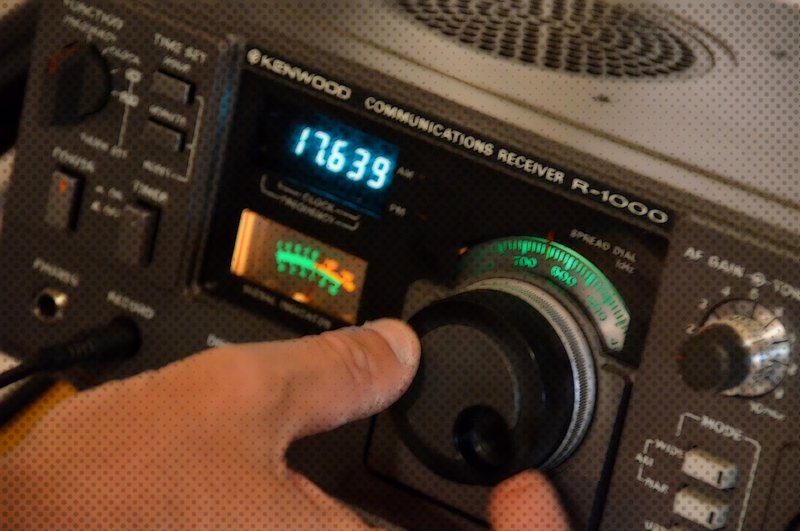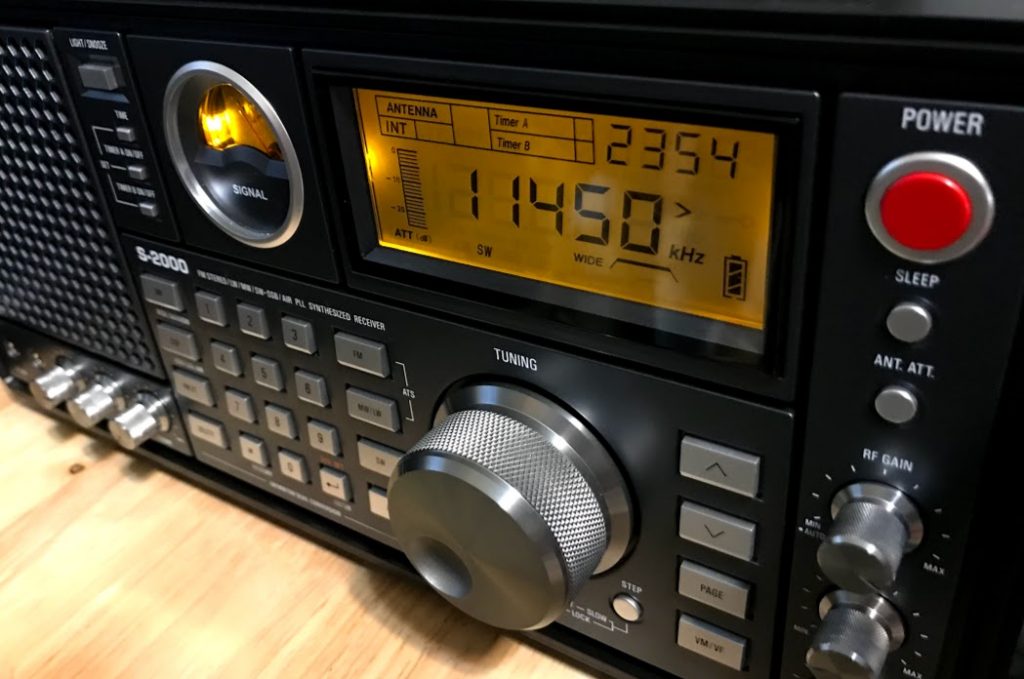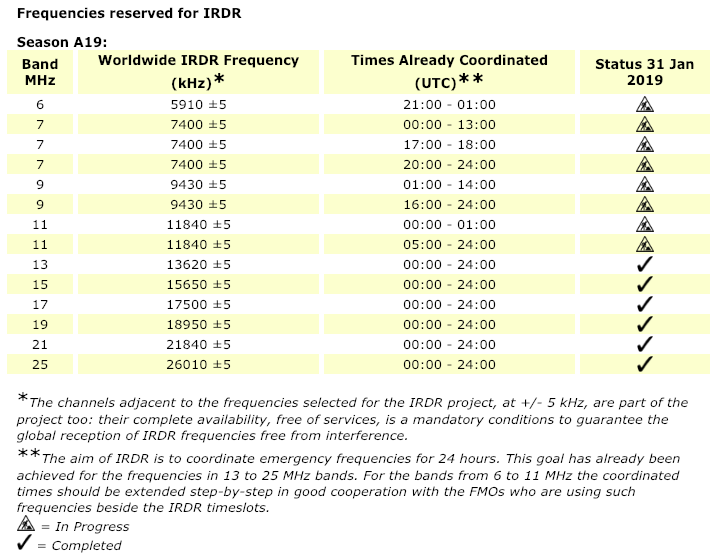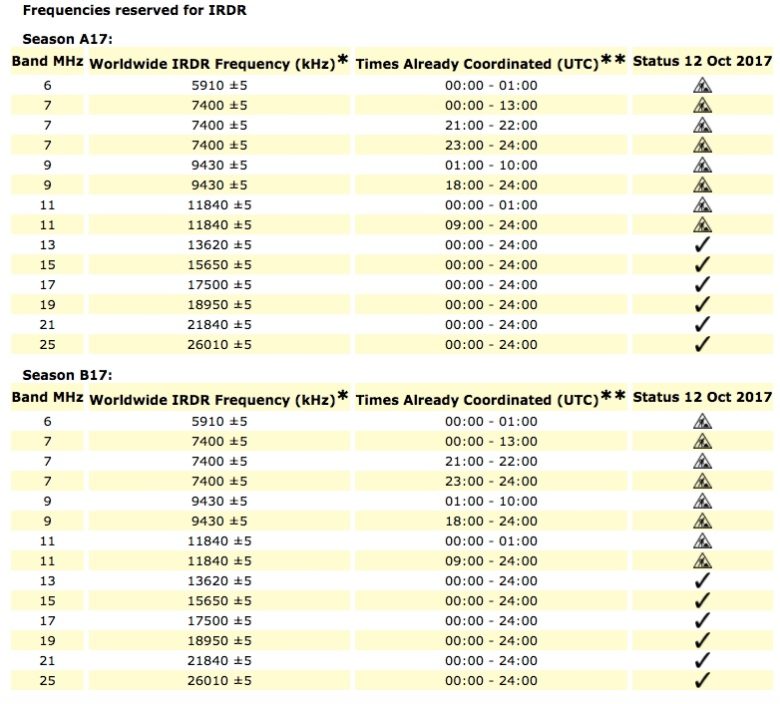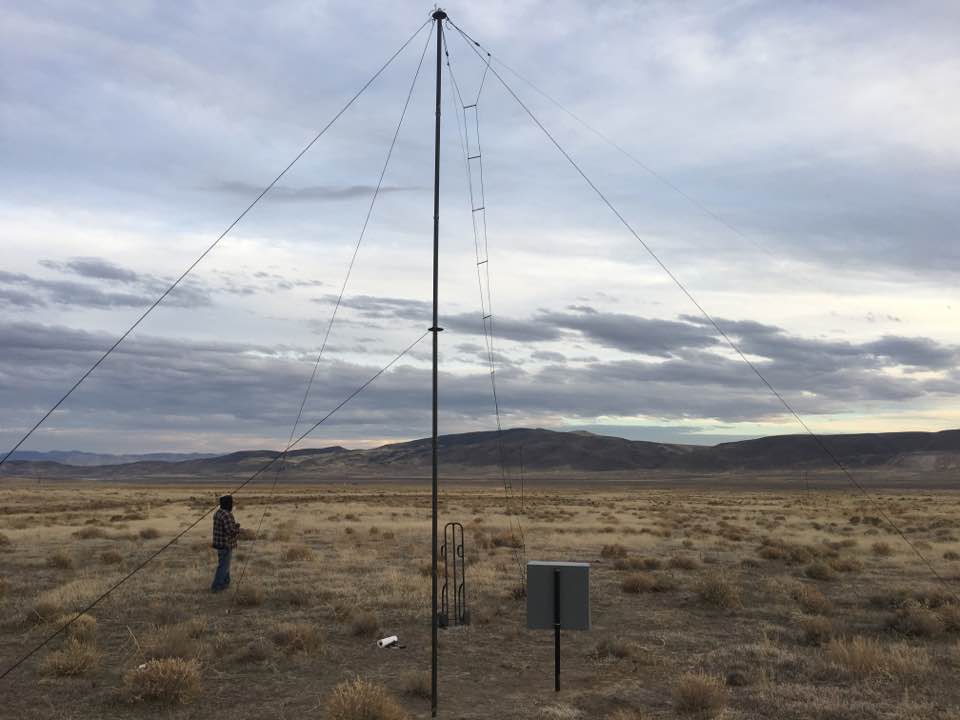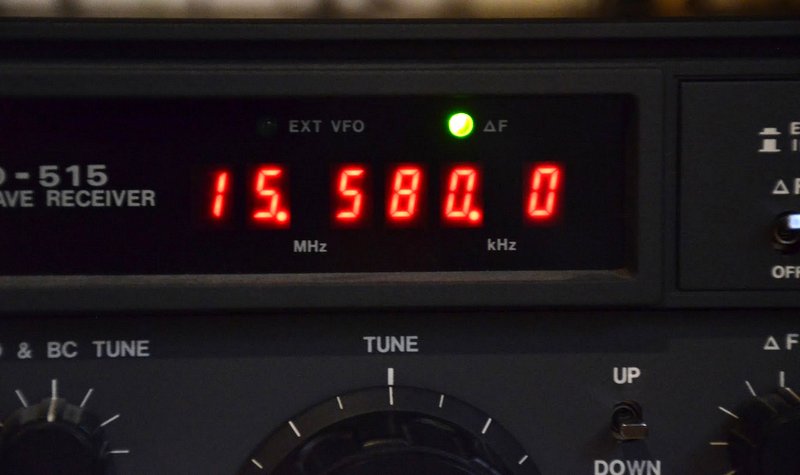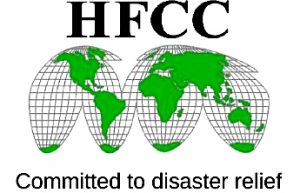Many thanks to SWLing Post contributor, Arecki, who notes that the HFCC shortwave broadcast schedules for the A20 summer period are now available.
Tag Archives: HFCC
Frequency coordination news and IRDR updates
Many thanks to SWLing Post contributor, Alan Hughes, who shares this article by WRMI’s Jeff White in Radio World magazine. Besides covering updates in the A19 broadcast season, and Radio Exterior de España’s increased broadcasts, Jeff notes frequencies and updates for the International Radio for Disaster Relief initiative.
For more information about the IRDR, check out the information below taken from this page on the HFCC website:
International Radio for Disaster Relief (IRDR)
Humanitarian Aspects of HFCC ActivitiesFrom its infancy since 1920s shortwave radio has been associated with its potential of being a communication tool in emergencies. This use of shortwave radio is still very much present among amateur radio enthusiasts for example, who discovered its long distance properties early in the twentieth century. Amateur radio provides a means of communication on shortwaves and other frequencies “when all else fails”. This role of amateur radio is well recognised, valued and appreciated both by the public and by the world institutions managing and regulating the use of the radio spectrum.
In contrast the huge technical potential of international shortwave broadcasting that operates transmitter facilities tens, or hundred times, more powerful than those of amateur radio, remains almost unused in emergencies. At the moment when local and even regional communication and information networks are needed most, they are destroyed or overloaded and the population suffers from an information blackout. Shortwave radio is capable of remaining the only source of information.
Although the life-saving role of radio broadcasting is widely recognised by the public, and confirmed by surveys conducted after the recent disasters – and even acknowledged by world leaders – no concrete projects have been ever designed and no regulatory framework has been developed.
That is why the HFCC – International Broadcasting Delivery in co-operation with the Arab States and Asia-Pacific broadcasting unions are working on an International Radio for Disaster Relief (IRDR) project that is based on the system of online co-ordination of frequencies managed by the HFCC in accordance with International Radio Regulations.
The HFCC is aware of the humanitarian aspects of international broadcasting. It pointed out in 2012 – as the UNESCO partner for the preparation of the World Radio Day – that terrestrial shortwave radio in particular is still considered as a powerful communication and information tool during emergency situations. Read more >>
Receivers are inexpensive and require no access fees. Shortwave radio is important for people living in remote and isolated regions of the world. It reaches across the digital divide to the most disadvantaged and marginalised societies. This is also in keeping with the Declaration and Action Plan of the World Summit on the Information Society.
The annual edition of the World Disasters Report of the International Red Cross and Red Crescent Societies (IFRC) issued in October 2013 stressed again that with only 6 percent of people in low-income countries using the internet in 2011 the digital divide is still stark, and access to low cost media technology is really the key.
The HFCC is a strong advocate for incorporating terrestrial broadcasting permanently on the disaster risk reduction agendas of the ITU and other UN agencies and institutions. It submitted two documents for the ITU-R Working Party 6A November 2013 meeting:
HFCC – The Importance of Terrestrial radio in International Broadcasting
HFCC – The International Radio for Disaster Relief ProjectBoth documents are annexes in Section 8 of the ITU-R Study Group 6 Report BT.2266 “Broadcasting for public warning, disaster mitigation and relief”. The report can be downloaded via this link.
A workshop was held during the November 2013 meeting addressing these issues. The web site of the Emergency Broadcasting Workshop can be accessed here. The web site also contains copies of all the presentations that were made at the workshop, and a Video interview with Christoph Dosch, Chairman of ITU-R Study Group 6 (Broadcasting service)
The HFCC has applied for membership in the CDAC (Communicating with Disaster Affected Communities) Network in keeping with the conclusion of the debate on emergency communication during the Bratislava B13 Conference. Read more >>
The HFCC is staying in touch with the Information and Communication Sector of the UNESCO agency on the preparation of the World Radio Days that are celebrated each year on February 13th.
Humanitarian aspects of terrestrial broadcasting were also on the agenda of the Global Kuala Lumpur conference in January 2014. Read Opening Remarks.
HFCC Announces the Passing of its Founder, Oldrich Cip
(Source: WRMI & HFCC)
HFCC Announces the Passing of its Founder Oldrich Cip
Oldrich Cip, founder and Vice Chairman of the High Frequency Coordination Conference, known as the HFCC, passed away on 27 July following a sudden illness.
Oldrich was involved in radio since he was a child — first as an amateur radio hobbyist and later as a staff member of Czechoslovak and then Czech Radio in the international broadcasting departments. A college graduate in the field of Humanities, he spent most of his working life as a frequency manager and schedule planner. For a number of years he hosted a DX program on Radio Prague under the pen name Peter Skala.
After the end of the Cold War, he believed that broadcasters from both sides of the conflict should come together and develop a new system of planning and coordination for shortwave broadcasting. This led to the establishment of the HFCC in 1991. Oldrich was Chairman of the HFCC until 2015. Since then, he was a Vice Chairman of the group.
Oldrich lived in Prague, although he frequently spent time in his country house, where he enjoyed woodworking, guitar and country music, vintage graphics, photography and time with his family. His son Vladislav said he spent his last day there: “He enjoyed a quiet evening in the country house, with our families, all four grandchildren around, no symptoms of anything bad coming. All of a sudden, he suffered probably a heart attack or stroke. An ambulance arrived immediately but he died a few hours later.”
Oldrich was married with two adult sons, Oldrich Jr. and Vladislav. Vladislav is the HFCC Secretary who manages the day-to-day operations of the organization.
From 1953 until 1997 Oldrich was an employee of Czechoslovak and later Czech Radio in Prague. He worked as a technical consultant for Czech Radio from 1998 to 2010. He specialized in planning schedules and frequencies, international coordination and distribution of shortwave radio programs for foreign countries.
Beginning in 1959 and for more than 25 years, Oldrich produced a weekly English-language program “Radio Prague Calling All Radio Hobbyists,” using the nom de plume Peter Skala. In the program, he answered questions from shortwave listeners in many countries and covered a variety of scientific and other topics from the radio industry.
During the Soviet occupation of Czechoslovakia in 1968, Oldrich used his technical expertise to aid the “free Czechoslovak Radio,” putting himself in danger in an effort to provide factual news and information about the events taking place. Thanks to the large number of smaller facilities of Czechoslovak Radio scattered all over Prague and complicated infrastructure that connected them, they were able to continue broadcasting for quite some time.
In the period of reforms around the year 1968, he established secret contacts with his colleagues from Western radio stations. He re-established the contacts after the fall of communism and started an initiative to eliminate interference on shortwave. He became the Chairman of the HFCC, which has continued to meet twice each year in different parts of the world for shortwave stations to coordinate their frequency schedules for the coming broadcast season, thus eliminating interference before each season begins. The principles of international coordination were incorporated into the ITU’s International Radio Regulations during the 1997 World Radio Conference.
Oldrich was also an adviser to the Government of the Czechoslovak Republic in the preparation of the first Radio and Television Broadcasting Act after 1990, as well as a member of several EBU and ITU radiocommunication working groups. At the HFCC, he spearheaded the International Radio for Disaster Relief project whereby shortwave stations have allocated specific frequencies in each band for the transmission of emergency information in the event of natural disasters around the world.
Jeff White, Oldrich’s successor as HFCC Chairman, said: “The shortwave broadcasting and listening communities have lost one of our most important proponents. The contributions of Oldrich over the years are simply unequalled. He was a humble man, but people in this industry realized the importance of his work. And he has left us a lasting legacy — an organization which has largely eliminated interference on the shortwave bands, and it has enabled stations to use less power to reach their target areas with a good signal. For that, he will always be remembered.”
Oldrich Cip was also a frequency consultant for WRMI. His assistance was greatly appreciated.
For more information, contact Jeff White, HFCC Chairman, at [email protected].
HFCC: International Radio for Disaster Relief (IRDR) schedule
(Source: HFCC via Larry W)
International Radio for Disaster Relief (IRDR)
Humanitarian Aspects of HFCC Activities
From its infancy since 1920s shortwave radio has been associated with its potential of being a communication tool in emergencies. This use of shortwave radio is still very much present among amateur radio enthusiasts for example, who discovered its long distance properties early in the twentieth century. Amateur radio provides a means of communication on shortwaves and other frequencies “when all else fails”. This role of amateur radio is well recognised, valued and appreciated both by the public and by the world institutions managing and regulating the use of the radio spectrum.
In contrast the huge technical potential of international shortwave broadcasting that operates transmitter facilities tens, or hundred times, more powerful than those of amateur radio, remains almost unused in emergencies. At the moment when local and even regional communication and information networks are needed most, they are destroyed or overloaded and the population suffers from an information blackout. Shortwave radio is capable of remaining the only source of information.
Although the life-saving role of radio broadcasting is widely recognised by the public, and confirmed by surveys conducted after the recent disasters – and even acknowledged by world leaders – no concrete projects have been ever designed and no regulatory framework has been developed.
That is why the HFCC – International Broadcasting Delivery in co-operation with the Arab States and Asia-Pacific broadcasting unions are working on an International Radio for Disaster Relief (IRDR) project that is based on the system of online co-ordination of frequencies managed by the HFCC in accordance with International Radio Regulations.
The HFCC is aware of the humanitarian aspects of international broadcasting. It pointed out in 2012 – as the UNESCO partner for the preparation of the World Radio Day – that terrestrial shortwave radio in particular is still considered as a powerful communication and information tool during emergency situations. Read more >>
Receivers are inexpensive and require no access fees. Shortwave radio is important for people living in remote and isolated regions of the world. It reaches across the digital divide to the most disadvantaged and marginalised societies. This is also in keeping with the Declaration and Action Plan of the World Summit on the Information Society.
The annual edition of the World Disasters Report of the International Red Cross and Red Crescent Societies (IFRC) issued in October 2013 stressed again that with only 6 percent of people in low-income countries using the internet in 2011 the digital divide is still stark, and access to low cost media technology is really the key.
The HFCC is a strong advocate for incorporating terrestrial broadcasting permanently on the disaster risk reduction agendas of the ITU and other UN agencies and institutions. It submitted two documents for the ITU-R Working Party 6A November 2013 meeting:
HFCC – The Importance of Terrestrial radio in International Broadcasting
HFCC – The International Radio for Disaster Relief ProjectBoth documents are annexes in Section 8 of the ITU-R Study Group 6 Report BT.2266 “Broadcasting for public warning, disaster mitigation and relief”. The report can be downloaded via this link.
A workshop was held during the November 2013 meeting addressing these issues. The web site of the Emergency Broadcasting Workshop can be accessed here. The web site also contains copies of all the presentations that were made at the workshop, and a Video interview with Christoph Dosch, Chairman of ITU-R Study Group 6 (Broadcasting service)
The HFCC has applied for membership in the CDAC (Communicating with Disaster Affected Communities) Network in keeping with the conclusion of the debate on emergency communication during the Bratislava B13 Conference. Read more >>
The HFCC is staying in touch with the Information and Communication Sector of the UNESCO agency on the preparation of the World Radio Days that are celebrated each year on February 13th.
Humanitarian aspects of terrestrial broadcasting were also on the agenda of the Global Kuala Lumpur conference in January 2014. Read Opening Remarks.
KIMF broadcast schedule via the HFCC
Many thanks to SWLing Post contributor, Ethan Best (KC9YDN), who notes:
KIMF’s schedule has been posted on the HFCC’s website:
Thank you for sharing this, Ethan!
KIMF has actually been in the HFCC listings since at least 2014, even though they only recently received FCC approval to operate.
HFCC A17 schedules now available
Many thanks to SWLing Post contributor, Richard Langley, who notes that HFCC A17 schedules for all stations are now available at http://www.hfcc.org/data/a17/index.phtml.
Thanks again, Richard!
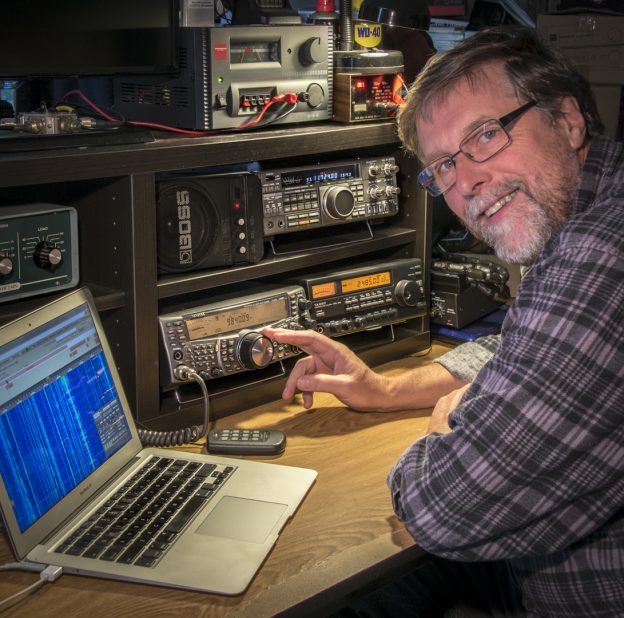
How to Identify Changes in Station Schedules
The shortwave bands are in a constant state of flux. And radio reception varies with the seasons. As a result, radio stations often need to alter their frequencies and times for best all-year-round reception at the listener’s location. There are two seasonal changeovers: the “A” transmission period coincides with the northern hemisphere summer (March to October), and the “B” transmission schedule for the winter period (October to March). Leading up to these changeovers, broadcasters plan their schedules for the coming season. The B16 transmission season began last weekend.
Want to improve your understanding of shortwave propagation characteristics? Study a few of the strategies employed by broadcast engineers at international radio stations during the twice yearly schedule changeovers. You’ll quickly learn much about how it all works!
Frequency changes by international broadcasters allow you the opportunity to observe the factors that come into play at BOTH the transmitter site and the reception target zone in another part of the world. Broadly speaking, we know that when winter arrives reception of the higher frequencies declines and the lower frequencies provide better reception. The reverse applies in summer – reception on the higher frequencies are enhanced and ionospheric absorption of signals increases at lower frequencies.
In addition, these characteristics change for both daytime and nighttime reception in summer and winter. Furthermore, some interesting reception opportunities occur in certain regions of the world during the summer and winter equinoxes. On top of this, factor in the 11-year sunspot cycle and the current monthly smoothed sunspot number (SSN). So, station engineers have quite a few variables to consider while selecting their preferred shortwave bands when targeting their signals to the listener’s location in some other part of the world! Perhaps one could even consider that these calculations as both a science and an art!
Next, the engineers representing each station have to sit down with their colleagues (competitors?) from other broadcasters and negotiate suitable frequency allocations in each of the preferred bands. This is why we have the existence of the High Frequency Coordination Committee (HFCC). Working together to find and register suitable frequencies that don’t interfere with other transmissions is an important part of successfully ensuring that everyone “wins”. The HFCC describes its role this way:
The main objective of the HFCC is to provide the representation and services for the promotion of an efficient and economical use of the short-wave radio spectrum, and the improvement of radio reception of shortwave broadcast transmissions worldwide……
HFCC’s main activity is a direct coordination of frequencies among frequency managers and specialists of broadcasters, administrations, transmission service providers and other organisations with the aim to facilitate the resolution or minimisation of mutual interference on short waves…..
Membership of the HFCC is open to all individuals and organisations that provide frequency management and planning for recognised shortwave broadcasters.
And it has to be said that the HFCC does a very good job at trying to resolve potential conflicts and clashes in frequency registration. But we didn’t always have this informal governing body. HFCC was only formed in 1990. Prior to that, there was much “rough and tumble” as stations tried to sort it out for themselves and avoid getting in each others way. Remember also, in the 1970s and 80’s there were many more shortwave broadcasters than there are today, each with very large operating schedules. For younger readers here, imagine the international bands being six or seven times busier than they are today!
Understanding propagation characteristics, frequency allocation, antenna beam headings, different time zones and many other aspects of international broadcasting have been a source of fascination for me, both as a shortwave listener and as an amateur (ham) radio operator.
Here are some things to consider when monitoring the change in transmission seasons:
- Learn the basics of shortwave propagation and the characteristics on display over a 24-hour period, seasonally, annually, and within the sunspot cycle. It’s a big topic and takes a while to really absorb it all!
- Familiarise yourself with which part of the spectrum the broadcaster can be expected to successfully utilise during a certain season.
- When finding a station on a new frequency (NF), try to locate and note down the formerly used frequency. Sometimes, that same station will return to the deleted frequency at the start of the next season (the next half of the year).
- Noting the deleted frequency often reveals that another station has taken up position on that channel.
- Check to see if the same transmitter site is used for the NF. With so many stations using a variety of relay sites these days, you cannot just assume that the same relay is being used for the NF as it was for the old frequency.
- Some station schedules are complicated and can be hard to decipher. Time changes, language changes, an increase or decrease in the number of frequencies the station employs for a particular service, daily broadcasts, weekends only, weekdays only, or only certains days of the week can make it tricky to reveal how the NF relates to the old frequency. Expect that you might sometimes get it wrong!
- A few stations (e.g. China Radio International or Radio Free Asia) use so many outlets for some broadcasts that it can be too hard to tell what was the replaced frequency. In those cases, I just throw up my hands and move on!
- Maybe the target location of the broadcast has changed. Checking the transmitter’s azimuth beam headings can help here.
Like other “old dudes”, I have spent many years observing and documenting the schedule changes of shortwave broadcasters. This is a part of the hobby that I personally find quite absorbing. However, I’m aware that it’s probably NOT something that some others might enjoy quite so much!
Since the B16 changes came in one week ago, I have been busy monitoring the bands to find the NFs and the deleted frequencies (the ex’s) and any other variations to the broadcasting schedules of each station.
There are HUNDREDS of changes to discover. But I can’t find them all – I also have to eat, sleep, and get on with life!
However, here is a list of the 93 observations I have made over just the past few days:
NOTE: Frequencies in kHz, Times in UTC
ABBREVIATIONS: NF = New Frequency, ex = deleted frequency, QRM = interference, // = another or parallel frequency used at the same time, As = Asia, SEAs = South East Asia, etc. Af = Africa, WAf = West Africa, etc. Eu = Europe, EEu = Eastern Europe, etc. NAm = Nth America, ENAm = Eastern Nth America, etc. Oc = Oceania
FORMAT: Freq – Country of Transmitter site – Station Name – Transmitter Location – comments.
5885 NTH MARIANA IS. RFA – Tinian. Korean to EAs at 1710, NF and good signal, Nov 4.
5910 OMAN. BBC – Al Seela. S/on 1700 in Dari to SEAs, NF, good signal, Nov 4.
5955 ROMANIA. RRI – Tiganesti. Italian to SEu, 1715, NF (ex 5910) and fair signal, Nov 4.
5965 NTH MARIANA IS. RFA – Tinian. Mandarin at 2030, NF and heavy jamming, Oct 31.
5970 TURKEY. VoT – Emirler. French to Eu, 2035, NF (ex 9635), fair signal Oct 31.
5980 TURKEY. VoT – Emirler. Turkish to Eu 2005, NF (ex 9460), good signal, Oct 31.
5990 ROMANIA. RRI – Galbeni. Romanian to Eu, 2040 to s/off 2100, NF (Believed to be ex 9500), good signal, Oct 31.
6010 CHINA. CRI – Urumqi. S/on 1800 in Amoy (Min Nan Chinese), NF (ex 13700) fair signal but QRM from Korean jamming on 6015, Nov 4.
6025 IRAN. VOIRI – Sirjan. German to Eu at s/on 1720, NF (ex 9660), good signal, Nov. 4
6040 CHINA. CRI – Urumqi. Russian to EEu at 1745 to s/off 1757, NF (possibly ex 11875 for this txer site) and excellent signal Nov 4.
6050 TURKEY. VoT – Emirler. English to Eu at 2015 to s/off 2025, NF (ex 9785), fair signal, Oct 31.
6060 IRAN. VOIRI – Zhaedan. Arabic to NAf at 1802, NF (ex 7285), fair signal, Nov 4.
6070 CHINA. CRI – Beijing. Russian to EEu at 1815, NF (ex 9560), very good signal Nov 4.
6090 OMAN. BBC – Al Seela. English WS to CAs and ME, 1820, NF (ex 7375), good signal and // 6195 also heard via Al Seela, Nov 4.
6100 CHINA. CRI – Beijing. English to Eu at 1800-1900, NF (ex 9600), excellent signal and // 7405 (via Beijing) which is also a NF and well heard on Nov 4.
Click here to continue reading the remaining 78 new frequency observations
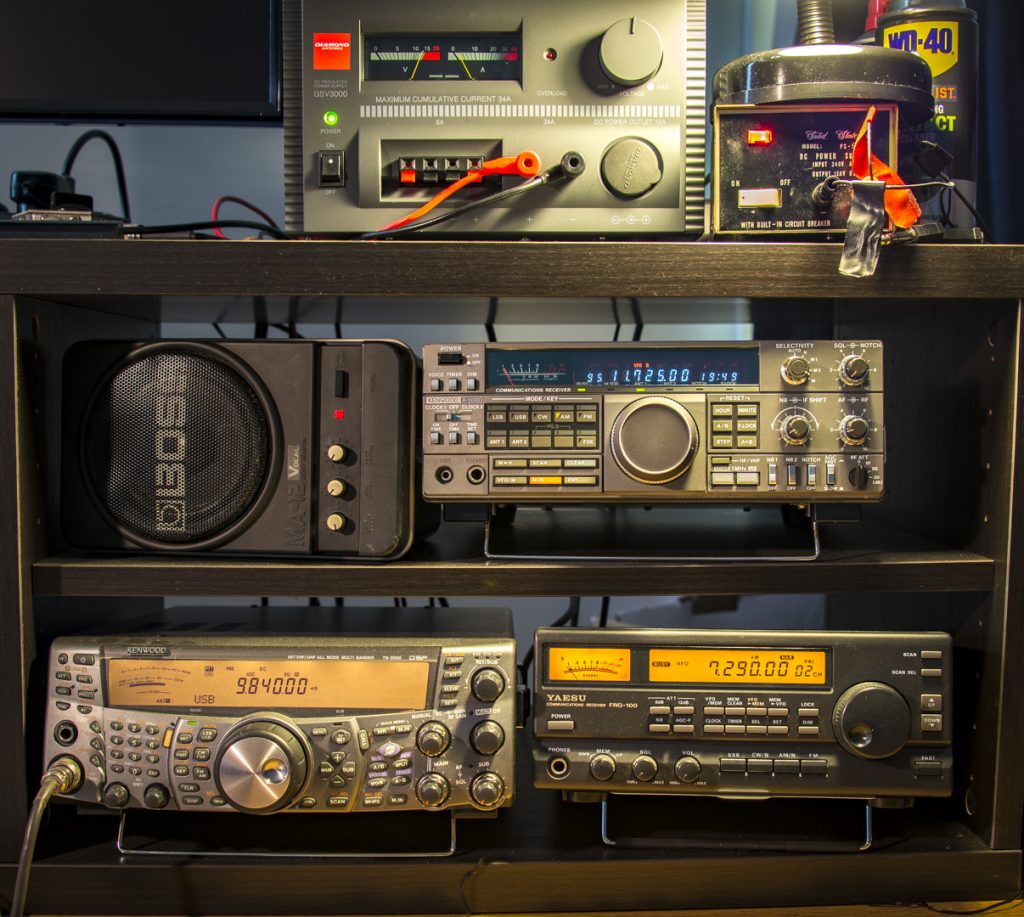
Part of Rob’s shack. Top Row: Two power supplies. Middle Row: Bose powered speaker, Kenwood R5000 receiver. Bottom Row: Kenwood TS2000 transceiver, Yaesu FRG100 receiver.
Rob Wagner, VK3BVW, is the author of this post and a regular contributor to the SWLing Post. He also blogs at the Mount Evelyn DX Report.

